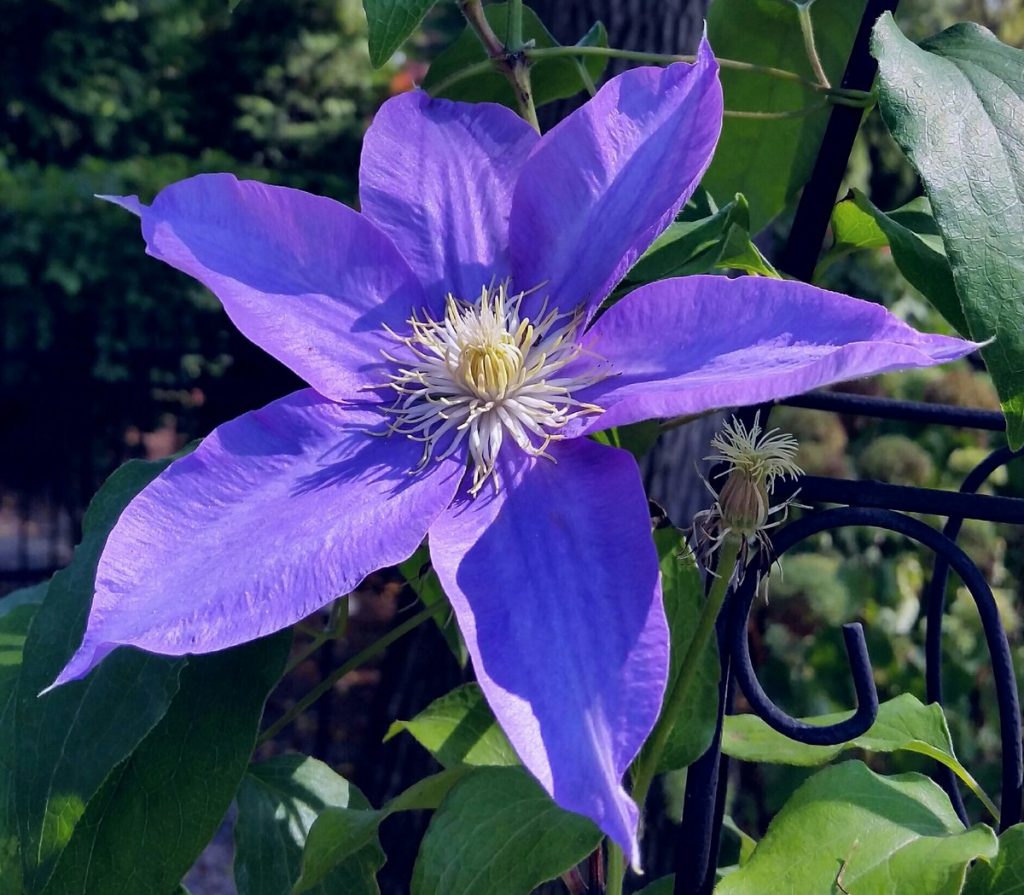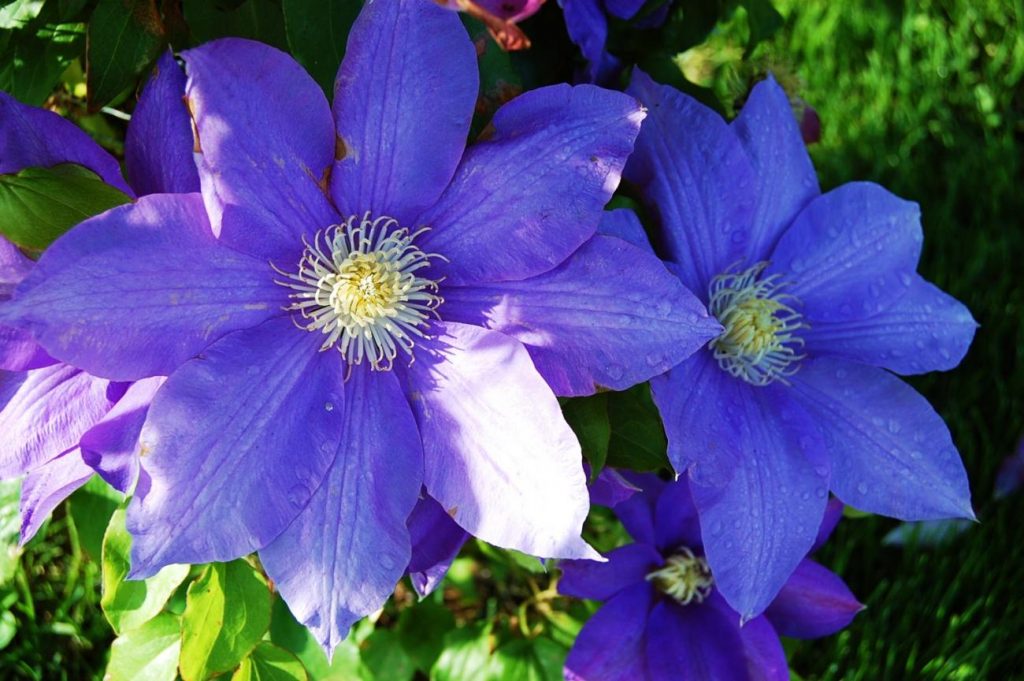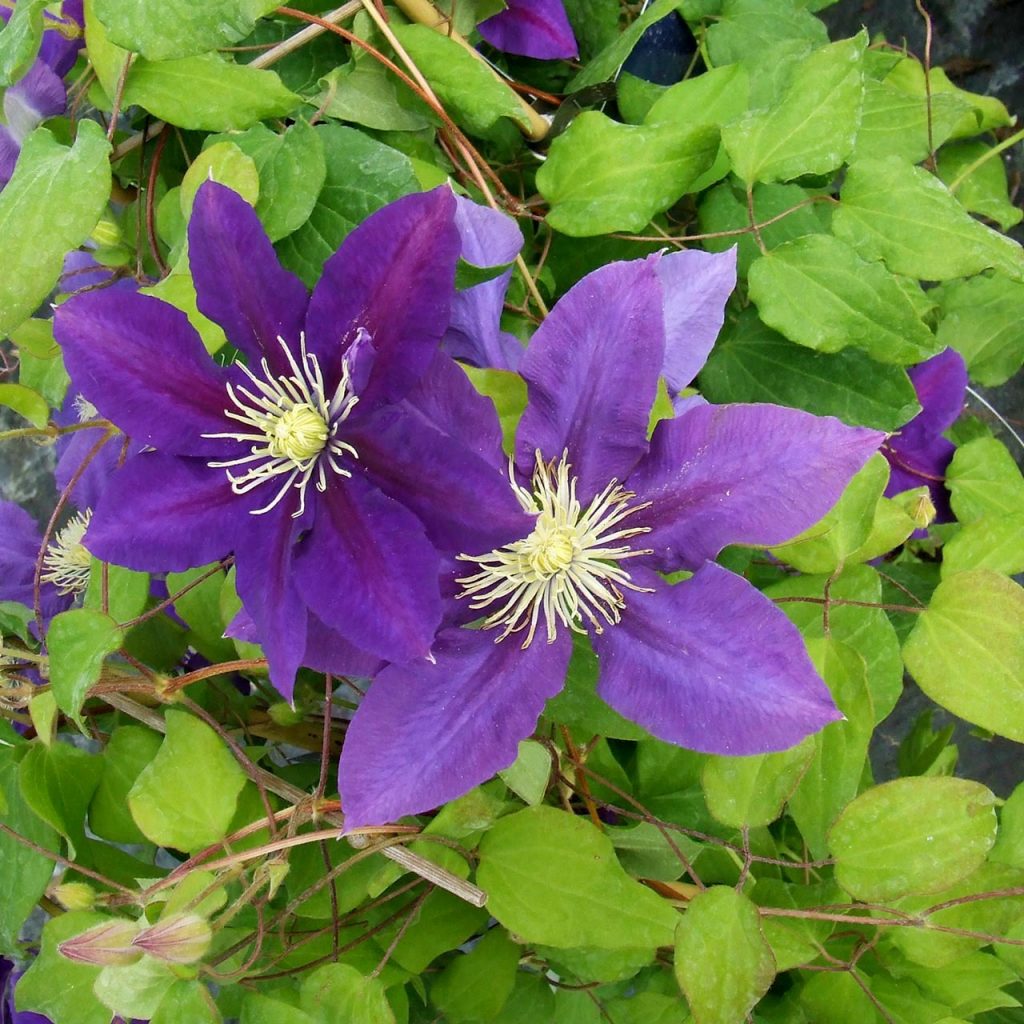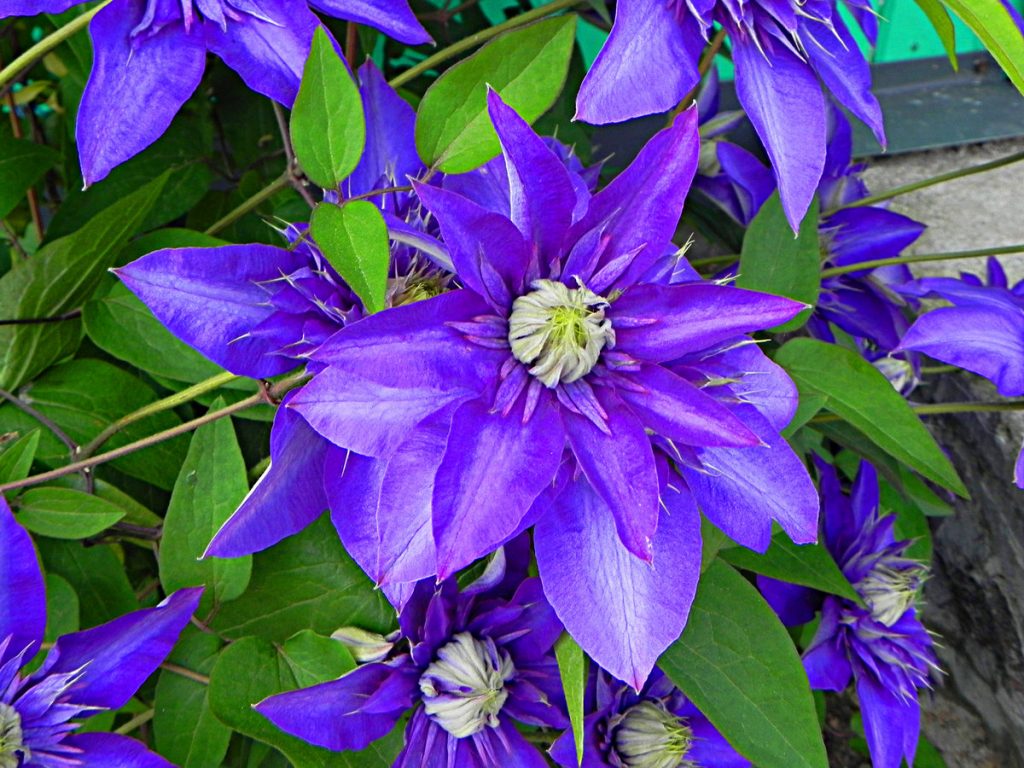Clematis Manchurian - description, planting and care
This plant is known to gardeners all over the world, but in Russian its name stuck in the wrong form. Clematis of Manchu actually sounds right in Latin as Clématis. Homeland - the temperate zone of the northern hemisphere. However, since the XIV century in Japan, and since the 16th century in Western Europe, clematis began to be actively cultivated.
- general description
- Landing features
- Seat selection
- Selection and preparation of planting material
- Landing technology
- Care
- Watering
- Top dressing
- Mulching and loosening the soil
- Pruning
- Shrub shelter for the winter
- Reproduction
- Seeds
- Cuttings
- By dividing the bush
- Layers
- Diseases and pests
- Use in landscape design
- Variety reviews
- Useful videos

Clematis mandschurica
general description
The Manchurian clematis is a herbaceous vine, considered by some botanists to be a species of direct clematis. Differs in flexible, branched stems up to 3 m in length, which do not coarse over the years, remaining soft. The surface of the stems is rough, which allows them to cling to any irregularities and use them as a support.
The leaves have a complex structure - each of them consists of many small segments. The flowers are small, white, gathered in panicle inflorescences.
On one liana, up to 500 buds can bloom at the same time. During the abundant flowering, the leaves are not even visible - it stops in a continuous fragrant carpet. That is why clematis is most often used for vertical gardening - hedges, gazebos.
The plant has a strong, pleasant aroma and color that intensifies in bright light. The plant tastes hot and can irritate the mucous membranes. This is necessary for those who have small children and pets.
The variety has another name - clematis. It is very unpretentious and does not need complicated care. It blooms only on fresh shoots of the current year, which greatly facilitates pruning.
Landing features
You can transfer clematis seedlings into the ground in any warm season. The main condition is the temperature above +10 ° С and the absence of the risk of frost. An adult clematis is quite cold-resistant, but a young stalk with a still undeveloped root system is vulnerable to low temperatures.

Clematis Manchu
The plant withers quickly, therefore it is impossible to keep the cutting with open roots for a long time - it must immediately be planted in the ground. If the seedling is sold with a closed root system, you can take your time with planting.
Sometimes the plant is pre-soaked in fungicides or biostimulants, but the opinions of gardeners about this procedure differ.
Seat selection
Clematis Manchu loves bright lighting. For him, it is better to choose the brightest place on the site on the southwest or southeast side.
If you plan to use the flower as a hedge, then you must immediately place it near the support. If the seedling is placed in an open place, next to it, columns or arches are dug in in advance for the subsequent growth of the vines.
Clematis prefers sandy soil, light, not allowing moisture stagnation. The plant will die if there is an excess of lime in the soil, but humus for it, on the contrary, will be useful.The flower should not be planted where groundwater rises close to the surface.
The roots are powerful, highly branched, they will rot and die from excess moisture. A strong wind will also kill clematis. Open space on a hill will not work for him.
Selection and preparation of planting material
If the seedlings were grown from seeds or cuttings on their own, then no special preparation for planting is required. Healthy, green, undamaged sprouts are simply placed directly into the soil. If the planting material was purchased in a store or nursery, you must first carefully examine it.
Pay special attention to seedlings sent by mail. Their quality is not always good, sometimes the plant runs the risk of damage during transportation.
- Shoots and roots of clematis should be even, without kinks and bends.
- The leaves should be free of spots, plaque or unevenly colored areas.
- The bark must not be damaged, otherwise the damaged spots must be treated with fungicides.
Sometimes on the seedlings brought from the store, you can see insect pests. This is bad, ideally it is better not to plant such a plant in the garden. The young plant will not tolerate treatment with powerful fungicides, and without it, the parasites cannot be completely removed. Their larvae can remain and then infect all neighboring flowers. If the desire to have such a flower is stronger, then after planting it will require several more treatments with preparations and constant monitoring of the condition of the seedling.
Landing technology
A pit for a flower must be prepared in advance, several months in advance. This is very important for the further rooting and development of a young plant, for its adaptation to a new place and healthy growth.

Clematis Manchu photo and description
The size of the pit is about 60x60 cm, up to 0.5 m deep.
Drainage is placed at the bottom - stones, expanded clay, broken red brick. It will not allow moisture to stagnate at the roots. If the groundwater is close, the drainage layer should be at least 0.5 m.
The soil is mixed with humus, compost, wood ash and covered over the drainage layer. The support is dug in first, behind which clematis will curl. Then the seedling is placed in the hole, spreading the roots.
Fall asleep with the remaining earth like this. In clematis, the root collar should be closed by 10-15 cm, then the root system will develop normally.
After planting, the soil around the seedling is mulched with sawdust or peat. The ground is watered abundantly 2-3 times so that the roots are saturated with moisture and take root more easily. Clematis will grow up to adulthood for 3-4 years, after which it will begin to bloom. This variety is able to delight flowering twice a year with care, regular feeding and proper pruning.
Care
Only with proper care, Clematis Manchurian will give a maximum of flowers upon reaching 4-5 years. Until that time, it is important to lay a good "base" by growing a healthy, strong, weather-resistant plant. It will take some effort and knowledge, but a lush bloom will be a reward for many years of work.
Watering
With good drainage and light soil, water the flower often, especially on hot days. The volume of liquid depends on the age of the plant. For a young seedling, 2 liters may be enough, while an adult bush will not have enough and 20 liters. Watering frequency is 2 times a week.
Watering is especially necessary in hot summer. At temperatures above +27 ° C, water clematis daily, more precisely, every evening. In daylight, the procedure is contraindicated, it can greatly harm the plant. Sometimes in the evenings the bush is sprayed with rainwater. It is also permissible to fertilize a flower by the foliar method - on a leaf.
Important! Water should be poured not under the trunk itself, but into the near-trunk circle, 10-15 cm from the center of the bush. So the branched roots of clematis are better saturated with moisture.
Top dressing
If, when planting, the soil was densely mixed with humus, compost and fertilizers, then the first year the plant will not need additional fertilizing. Overfeeding will be dangerous for a young seedling.It should be fertilized from the second year, immediately after the snow melts. In the spring, the vine needs nitrogen in order to grow and intensively increase the green mass.

Manchu clematis
At this time, it is better to apply nitrogen mineral fertilizer - urea, ammonium nitrate, ammonium sulfate.
In the summer, before flowering, fertilizers with a high potassium content are applied - wood ash, potassium sulfate, sylvinite.
After flowering, the plant needs phosphorus (it is contained in superphosphate).
In autumn, clematis is fed with rotted manure - it contains all the trace elements for the health of the bush and its future lush flowering. Fresh manure is not suitable - it burns the roots.
Watering the plant with organic matter is allowed both during flowering, and after it. There are several popular recipes for good dressing for garden flowers:
- Ash infusion. Use only ash from wood burning, not household waste, grass or foliage. 2 liters are diluted in 5 liters of boiling water, insisted for 24 hours. Proportions: 1 liter of infusion in a bucket of clean water.
- Onion peel. 20 g is poured into 5 liters of water, brought to a boil, covered with a lid and insisted for 4-5 days. Water at the root or spray on the leaves.
- Top dressing from nettles. Cut fresh herbs and put them in a bucket (1/3 containers), fill with water and cover. Fermentation will begin, after 2 weeks the natural feeding is ready.
- Potato broth, tea leaves, coffee grounds. It is difficult to overdose them, there are no contraindications and bad consequences. The plant will respond to this fertilization with abundant and long flowering.
Mulching and loosening the soil
Although clematis loves light and warmth, its roots are afraid of overheating - they should be additionally covered with mulching. Sawdust, peat, shredded tree bark are all suitable for protecting the root system. The roots need air access, so the soil must be periodically loosened after watering.
Weed grows more actively under the layer of mulch. This should not be allowed, especially with young clematis seedlings. Their roots are still weak to resist the weeds that suck all the juices from the soil. The weeding procedure should be repeated every two weeks to keep the weeds from overgrowing.
Pruning
Clematis have three main pruning groups. It is important to determine which of them this or that variety belongs to, so that the procedure is carried out correctly.

Clematis Manchu description photo
Clematis Manchurian belongs to the Flamula-recta group, which includes herbaceous varieties with pleasantly smelling small flowers. They all need a lot of pruning - the easiest option for gardeners.
The plant is pruned in the fall, after flowering completely. Some clematis bloom again at the end of summer, it is important to wait for the final bud fall.
Everything is extremely simple - the shoots are removed with a pruner above the soil layer, leaving only 10-15 cm of the trunk with two buds on the surface. When planting for the first time, pruning young vines is not worth it - this will greatly weaken the plant.
Shrub shelter for the winter
For successful wintering, clematis must be properly prepared. Since August, nitrogen fertilization has been stopped so as not to stimulate the pre-winter growth of young shoots and leaves. They will still have to be cut, and the plant will spend extra energy on their reproduction. When applying mineral fertilizers at the end of summer, it is important to ensure that there is no nitrogen in their composition.
In September, it is good to feed the plant with potassium-phosphorus fertilizer or organic matter. The rotted manure will also serve as a heater for the roots of clematis in winter. All clematis, regardless of the type and variety, need such a recharge. Then, before the very frosts, pruning is needed. In the case of Manchurian clematis, it is complete, which simplifies the procedure for sheltering for the winter.
When covering a flower, one must remember about protection not only (and not so much) from frost, but from dampness. A plant can rot away much earlier than it freezes. After pruning, humus is poured onto the root collar, forming a small mound.A "pillow" is created from spruce branches, boards or cut lianas, which is laid out around the trunk. This will protect the roots from freezing. In clematis of 1 and 2 types of pruning, shoots removed from the support are laid on it.
A slate or a wooden board is laid on top of the "pillow". The first option is preferable - it does not rot, insects and fungus do not start in it. In winter, it is important to ensure that the covered plants are always under a layer of snow. If the winter is warm and the snow cover is thin, then you will have to fill it up from other areas. During a thaw, care must be taken that the plant is not under water. Freezing into the ice, it will certainly die.
Reproduction
As a species plant, clematis reproduces both vegetatively and by seeds. There are four breeding methods in total, each of which has advantages and features. In general, this process is simple, clematis takes root well and after a few years from a small sprout it becomes a full-fledged adult plant.

Clematis Manchu photo
Seeds
The Manchurian variety has medium-sized seeds; they are planted in late February - early March. It is better to take the planting material of the current year - the percentage of germination is greatly reduced over the years. Previously, the seeds are soaked in rainwater (melted snow is suitable) or a biostimulator for 4-5 days. You can do without soaking, but then the seedlings will have to wait 1.5-2 weeks longer.
The soil should be light - usually a mixture of peat, garden soil and coarse sand is used. It is pre-calcined in a conventional or microwave oven and poured over with warm water. Seeds are sown at a distance of 5 cm from each other. The container is covered with glass or wrapped in foil. The temperature for germination should not be lower than +27 ° C; for this, a lamp is placed above the planting box. Under favorable conditions, the first shoots will appear in a month.
It is better to water seeds and young sprouts through the tray. This will eliminate the risk of flooding, mold will not appear on the surface of the soil. After the appearance of 2-3 true leaves, the seedlings begin to accustom them to fresh air. The film is removed, the plant is gradually hardened, airing the room. In open ground, seedlings are transferred in May after the last frost. Then they take care of them, as for an adult plant.
Some gardeners prefer to arrange temporary greenhouses for young sprouts on the site. The seedlings are transferred to them in the first year, and then they are kept there for another 2-3 years. Only in the 4th year after planting, young plants are transferred to a permanent place. So there is a greater chance that clematis will take over and begin to grow and bloom better in the future.
Cuttings
In the spring, after the snow melts, the plant wakes up and starts growing. Manchurian clematis is cut off completely for the winter, so the first young shoots appear closer to May. At the same time, 1-2 lianas are cut into cuttings. Each of them should contain 2-3 live buds. It is convenient to root them both in water and in soil, but the latter option is preferable.
It is better to take the substrate of the following composition: fertile soil, vermiculite, perlite. The cuttings are pre-dipped in Kornevin for 2-3 hours, then placed in the ground, poured with water and covered with a jar on top. In such a greenhouse, at + 25 ° C, rooting occurs in 2-3 weeks. As soon as a new leaf appears on the handle, it has taken root and is ready to remove the greenhouse.
The cuttings are gradually accustomed to room temperature. During this period, they are still vulnerable. It is important that there are no sudden changes in temperature. This period usually coincides with the end of the heating season in apartments, but a sharp cold snap in the room can destroy the young plant. Cuttings are placed next to a heater or lamp, gradually accustoming them to a lower temperature. They are planted in the ground in the summer - in July.
By dividing the bush
Adult bushes, which are 5-6 years old or more, need to be divided. They form several points of growth, they are cramped, the roots are intertwined, there are not enough nutrients.Therefore, the procedure for dividing a bush is not only a method of reproduction, but also a rejuvenation of a plant, its sanitary thinning. Without this, the bush will stop blooming after 6-7 years. He will not have enough strength and nutrition to form buds.
In the fall, after the complete flowering, the bush is dug up, the ground is shaken off and the shoots are carefully separated according to the growth points. This is not difficult to do, individual "rosettes" disintegrate themselves, all that remains is to separate their roots. Bushes are planted in different holes at a distance of at least 40 cm from each other. The planting procedure is completely the same as described above. Before the pestilences, the plants will harden, and after wintering they will grow and bloom.
Layers
The main condition is the availability of free space under the bush. Next to the main plant, they dig a hole (or several), bend the shoot to it and sprinkle it with earth. Water it periodically for better rooting. By the fall, the layers will take root, during pruning they are separated from the mother bush and covered for the winter. They are transplanted to a new place in the spring, in May, when the plant wakes up and is ready to grow.
Diseases and pests
The root system of clematis is very developed, this provokes the formation of a fungus. For prevention, periodically loosen and dry the soil around the bush, but these measures are not always enough.

Clematis manchu white
If the plant begins to wilt, wilts and loses leaves, this may be a symptom of root damage by fungal spores. In this case, it is watered several times with a solution of Fundazol or another fungicide (Fitosporin, Skor).
A brown bloom on the leaves indicates a lesion with gray rot. All damaged shoots are removed and burned. The bush is treated with Fundazole solution or Bordeaux liquid. The procedure is repeated 2-3 times. The same measures are taken if clematis affects powdery mildew. It is easy to recognize it by the white bloom on the shoots and leaves. It is important to start treatment immediately, before the neighboring bushes become infected.
The yellowing of the foliage and shedding of the buds indicate the defeat of the bush by a spider mite. The pest drinks juices from young leaves and unblown flowers. You can fight it with the help of acaricides - Antiklesch, Aktara, Aktellik. The plant is treated twice with an interval of 10-12 days.
Delicate shoots and leaves of clematis are often eaten by slugs. It is easiest to lay out baits (for example, cabbage leaves) under the bushes and then collect pests. A protective strip of lime or crushed eggshells on the ground around the bushes also helps. Slugs cannot crawl over the obstacle, fearing to injure the delicate abdomen. They are hand-picked early in the morning on the way to the plant.
Use in landscape design
Clematis is ideal for vertical landscaping, thanks to its ability to densely braid any surface, covering it with shoots and flowers. Sometimes clematis is used as a flowering carpet, but this complicates its care and more often leads to damage to the shoots by diseases and pests. It is better to build an arch and plant a plant along it, making a decorative "gate" to the garden.

Clematis Manchu planting and care
Clematis is good for the formation of natural arbors. Unlike a vine, its shoots are not so heavy, there is no risk of shifting and falling of the supports. Blooming lianas will create a pleasant shade and decorative effect. With their help, you can also hide outbuildings in the back of the yard. Having planted a bush near the wall of a shed or garage, they stretch the cables to the roof and let the plant through them. Soon, the building will be completely hidden behind a wall of foliage and flowers.
Clematis in landscape design is often combined with climbing roses. Together they create wonderful, fragrant compositions. They decorate the front entrance to the house, in this they have no equal. Pomegranates are planted around lampposts, trees or gazebos. Throughout the season, until the very frost, the plant will decorate the garden, decorating any of its elements.
Variety reviews
Many gardeners say that this variety is "for the lazy". This refers to its unpretentiousness and ease of care. The only negative is that the plant blooms late - 4-5 years from planting. But with constant competent feeding, it blooms magnificently twice a year.
Most note the ease of pruning Manchurian clematis. Even an inexperienced florist can handle it. Shelter for the winter is also not a problem. The variety itself is winter-hardy, therefore it does not freeze even in severe frosts. It is easy to propagate the bush; you can choose any suitable method.
This unpretentious, luxuriantly flowering plant is a real decoration of any garden. With a little effort, a hedge, gazebo or wall decoration is ready. Clematis can grow and bloom in one place for many years, delighting with beauty and wonderful aroma.

